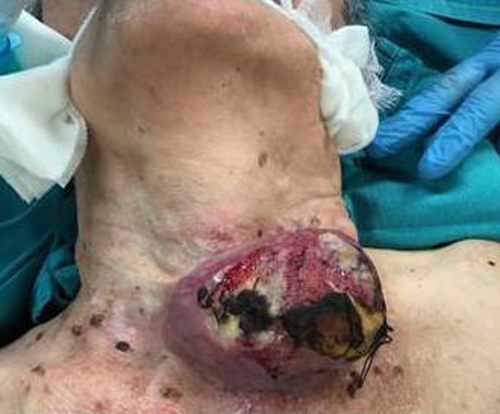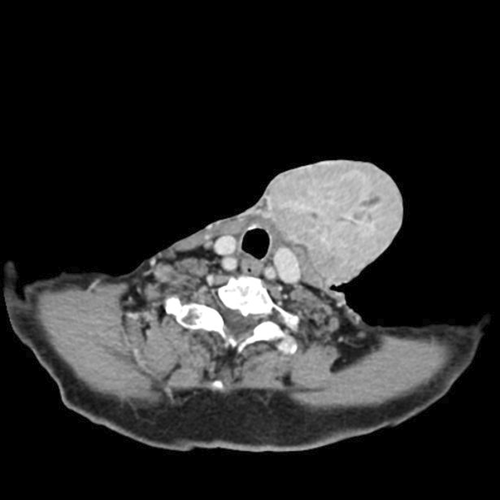Large papillary thyroid cancer bed recurrence causing overlying skin ulceration and bleeding
Abstract
Salvage surgery is an acceptable option for palliative treatment of thyroid bed recurrence in metastatic papillary thyroid carcinoma when other non-invasive options fail to control local skin complications.
A 86-year-old female patient presented to the emergency department with active bleeding from an ulcerated large anterior neck mass. The patient underwent right hemithyroidectomy 18 years prior for a low risk for recurrence stage I pT1bpN0M0 papillary thyroid cancer (PTC) followed 1 year after by completion thyroidectomy plus right central-neck dissection. Pathology was notable for a stage III pT1pN1M0 PTC with intermediate risk for recurrence. However, the patient declined adjuvant RAI and follow-up. Upon admission, clinical examination revealed a large, freely-mobile, non-tender, soft anterior neck mass covered by a network of enlarged veins with multiple skin ulcerations (Figure 1). The patient was under levothyroxine treatment. Thyroid function and serum Tg-antibodies were normal, and serum Tg was 237 ng/ml. Neck-ultrasound depicted a U5 (malignant) 81 × 42 × 55 mm solid hypoechoic nodule with irregular outline, microcalcifications, and increased intranodular vascularity. FNA was suggestive of PTC. CT revealed a solid irregular with increased vascularity thyroid-bed nodule without lymph-node involvement (Figure 2). PET/CT revealed extensive metastization into lung.


1 QUIZ QUESTION: WHAT ARE THE TREATMENT OPTIONS?
Based on patient's advanced age and extensive metastatic disease, palliative non-medical (radioactive iodine therapy, targeted therapy, chemotherapy) treatment was initially decided.1 However, as active bleeding from the ulcerated skin surface did not respond to local silver nitrate treatment, and external beam radiation therapy and electrochemotherapy were not available,2 salvage resection of the large thyroid bed PTC recurrence performed with uneventfull recovery (Figure 3A,B).

AUTHOR CONTRIBUTIONS
All authors equally accessed the data and contributed to the preparation of the manuscript. BKA and HA were equally responsible for making and performing treatment decisions. HA reviewed the manuscript for critical intellectual content and had the final approval.
ACKNOWLEDGEMENTS
The authors would like to acknowledge the substantial contribution of the patient for giving the written informed consent and the medical staff of our surgical department for the management of the patient. The present article represents an expanded version of an authors' previous educational publication in archives of HELLENIC MEDICINE https://www.mednet.gr/archives/contents2021-3-en.html.
CONFLICT OF INTEREST
The authors declare that they have no conflict of interests.
CONSENT
Written informed consent was obtained from the patient to publish this report in accordance with the journal's patient consent policy.
STATEMENT OF HUMAN AND ANIMAL RIGHTS
The present article does not contain any studies with human or animal subjects performed by any of the authors.
Open Research
DATA AVAILABILITY STATEMENT
Data sharing is not applicable to this article as no datasets were generated or analyzed during the current study.




